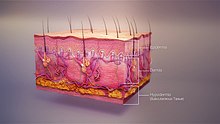
Back Velkondisies Afrikaans مرض جلدي Arabic Dermatoz Azerbaijani চর্ম সংক্রান্ত জটিলতা Bengali/Bangla Trastorn cutani Catalan Hautkrankheit German Enfermedad cutánea Spanish Larruazaleko afekzio Basque بیماریهای پوستی Persian Ihotauti Finnish
| Skin condition | |
|---|---|
| Other names | Cutaneous condition |
 | |
| 3D medical illustration showing major layers of skin | |
| Specialty | Dermatology |
| Causes | Bacteria, viruses, fungi, parasites, insects, trauma, cancers, allergies, toxins, vitamin/nutritional deficiencies/excesses, prolonged pressure, impaired blood circulation, ingrown hairs or nails, autoimmune conditions, aging, sun exposure, radiation exposure, exposure to heat/cold, dryness, humidity, other organ damage or condition, substance usage or contact, hereditary conditions, etc. |
A skin condition, also known as cutaneous condition, is any medical condition that affects the integumentary system—the organ system that encloses the body and includes skin, nails, and related muscle and glands.[1] The major function of this system is as a barrier against the external environment.[2]
Conditions of the human integumentary system constitute a broad spectrum of diseases, also known as dermatoses, as well as many nonpathologic states (like, in certain circumstances, melanonychia and racquet nails).[3][4] While only a small number of skin diseases account for most visits to the physician, thousands of skin conditions have been described.[5] Classification of these conditions often presents many nosological challenges, since underlying causes and pathogenetics are often not known.[6][7] Therefore, most current textbooks present a classification based on location (for example, conditions of the mucous membrane), morphology (chronic blistering conditions), cause (skin conditions resulting from physical factors), and so on.[8][9]
Clinically, the diagnosis of any particular skin condition begins by gathering pertinent information of the presenting skin lesion(s), including: location (e.g. arms, head, legs); symptoms (pruritus, pain); duration (acute or chronic); arrangement (solitary, generalized, annular, linear); morphology (macules, papules, vesicles); and color (red, yellow, etc.).[10] Some diagnoses may also require a skin biopsy which yields histologic information[11][12] that can be correlated with the clinical presentation and any laboratory data.[13][14] The introduction of cutaneous ultrasound has allowed the detection of cutaneous tumors, inflammatory processes, and skin diseases.[15]
- ^ Miller JH, Marks JG (2006). Lookingbill and Marks' Principles of Dermatology. Saunders. ISBN 1-4160-3185-5.
- ^ Lippens S, Hoste E, Vandenabeele P, Agostinis P, Declercq W (April 2009). "Cell death in the skin". Apoptosis. 14 (4): 549–569. doi:10.1007/s10495-009-0324-z. PMID 19221876. S2CID 13058619.
- ^ King LS (1954). "What Is Disease?". Philosophy of Science. 21 (3): 193–203. doi:10.1086/287343. S2CID 120875348.
- ^ Bluefarb SM (1984). Dermatology. Upjohn Co. ISBN 0-89501-004-6.
- ^ Cite error: The named reference
Lynchwas invoked but never defined (see the help page). - ^ Tilles G, Wallach D (1989). "[The history of nosology in dermatology]". Annales de Dermatologie et de Venereologie (in French). 116 (1): 9–26. PMID 2653160.
- ^ Lambert WC, Everett MA (October 1981). "The nosology of parapsoriasis". Journal of the American Academy of Dermatology. 5 (4): 373–395. doi:10.1016/S0190-9622(81)70100-2. PMID 7026622.
- ^ Jackson R (May 1977). "Historical outline of attempts to classify skin diseases". Canadian Medical Association Journal. 116 (10): 1165–1168. PMC 1879511. PMID 324589.
- ^ Copeman PW (February 1995). "The creation of global dermatology". Journal of the Royal Society of Medicine. 88 (2): 78–84. PMC 1295100. PMID 7769599.
- ^ Wolff K, Johnson RA, Suurmond R (2005). Fitzpatrick's Color Atlas and Synopsis of Clinical Dermatology (5th ed.). McGraw-Hill Medical Pub. Division. ISBN 0-07-144019-4.
- ^ Werner B (August 2009). "[Skin biopsy and its histopathologic analysis: Why? What for? How? Part I]". Anais Brasileiros de Dermatologia (in Portuguese). 84 (4): 391–395. doi:10.1590/s0365-05962009000400010. PMID 19851671.
- ^ Werner B (October 2009). "[Skin biopsy with histopathologic analysis: why? what for? how? part II]". Anais Brasileiros de Dermatologia (in Portuguese). 84 (5): 507–513. doi:10.1590/S0365-05962009000500010. PMID 20098854.
- ^ Xu X, Elder DA, Elenitsas R, Johnson BL, Murphy GE (2008). Lever's Histopathology of the Skin. Hagerstwon, MD: Lippincott Williams & Wilkins. ISBN 978-0-7817-7363-8.
- ^ Weedon's Skin Pathology, 2-Volume Set: Expert Consult – Online and Print. Edinburgh: Churchill Livingstone. 2009. ISBN 978-0-7020-3941-6.
- ^ Alfageme F, Cerezo E, Roustan G (April 2015). "Real-Time Elastography in Inflammatory Skin Diseases: A Primer". Ultrasound in Medicine & Biology. 41 (4): S82–S83. doi:10.1016/j.ultrasmedbio.2014.12.341.